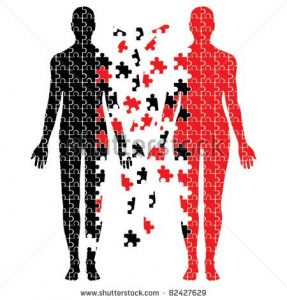I n 1998, Canetto and Sakinofsky suggested what they referred to as “The gender paradox in suicide”: in western countri
n 1998, Canetto and Sakinofsky suggested what they referred to as “The gender paradox in suicide”: in western countri
es women have higher rates of thinking and behaving in a suicidal way, but deaths from suicide are typically in men. The most superficial explanation, already rejected because of its simplicity and scant explanatory capacity, is that women tend more to call attention rather than really commit suicide. It is men who show a more “real” conduct: when they decide to commit suicide they do so: if women were really determined to kill themselves, they would also “really” do so.
But if we use the SGBA Sex and Gender –based analysis) clear differences are revealed in the experience
undergone, the behaviours adopted and the social roles of men and women: Moreover, the prejudices which are implicit in many of the diagnostic tools come to the fore. And this is not a trivial matter since in ad
dition to awareness of one of the mechanisms underlying the behaviour of human beings, namely suicide; we are playing with the effectiveness of preventive measures against suicide. In fact, to be able to tackle them effectively, we need to be able to try to understand the mechanisms of this gender paradox.
Expectations play an important role in manifesting this paradox; it becomes more intense in communities and groups in which different conduct is expected from men and women regarding suicide. These expectations also impinge on the scenarios chosen by men and women in the different ways in which suicidal behavior is interpreted for one or the other (Canetto and Sakinofsky, 1989).
Payne, Swami and Stanistreet (2008) insist particularly on how the socially created differences from masculinities and femininities have an impact on suicide-related behaviour. Individual factors and life history, social and community variables and working conditions passed through the sieve of the social construction of gender impinge on suicide-related behavior, as one more of the health-related types of beha vior.
vior.
The duration of the suicide process is much shorter in men than in women (Schrijvers, Bollen and Sabbe, 2012). This may be due to the well known and studied fact that traditional male norms mean that they, as a group, are less liable to seek help and care; to reveal what from a traditional male role could be considered as weakness, and also they are more prone to serious self-injury or use toxicomony as a form of self medication for depression or anxiety.
We know that often mental illnesses are infradiagnosed in men and their mental health problems are frequently deemed to be a “silent crisis”. The decision to ask for health is often made by men in a crisis situation and not during the course of the problems or the illness.
Prevention also needs to use an SGBA. It must be borne in mind that, as in the case of cardiovascular health, the symptoms are not the same in men and women and the illness is not diagnosed or treated in the same way. There is a need to have differential programs for suicide prevention with a gender perspective.



Comentarios